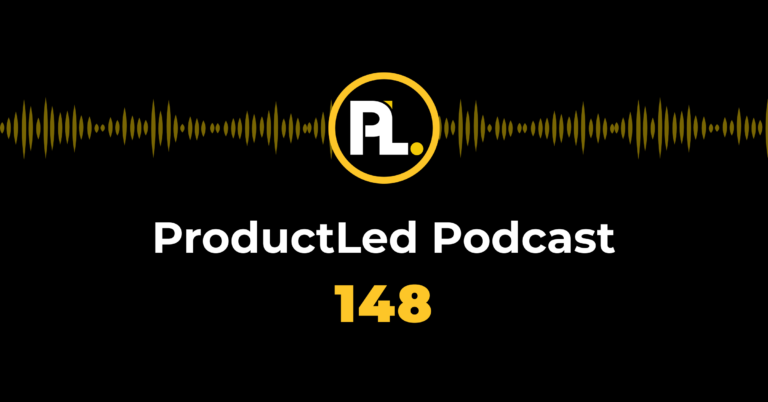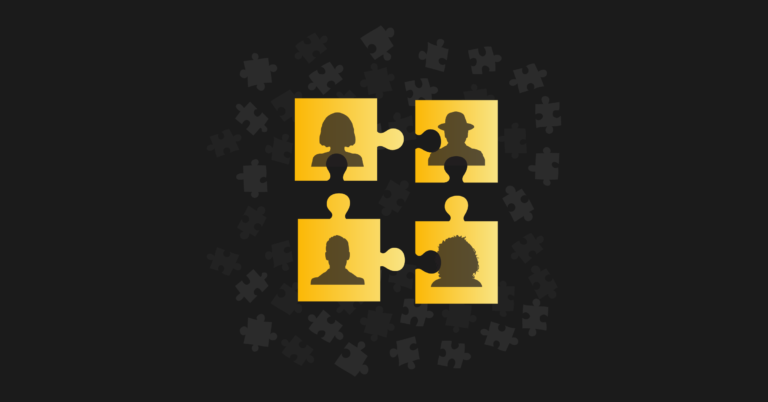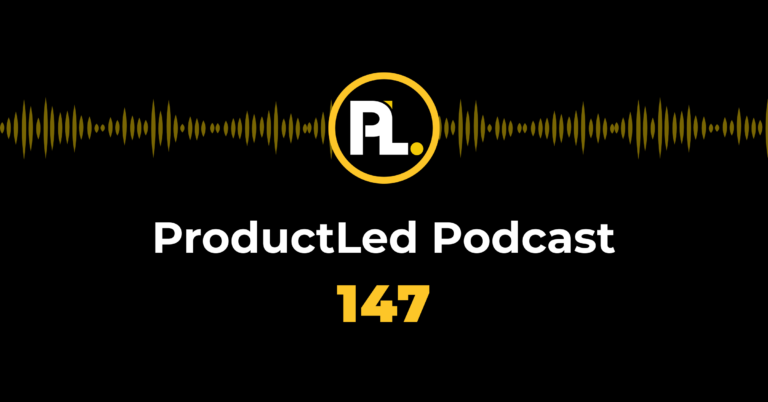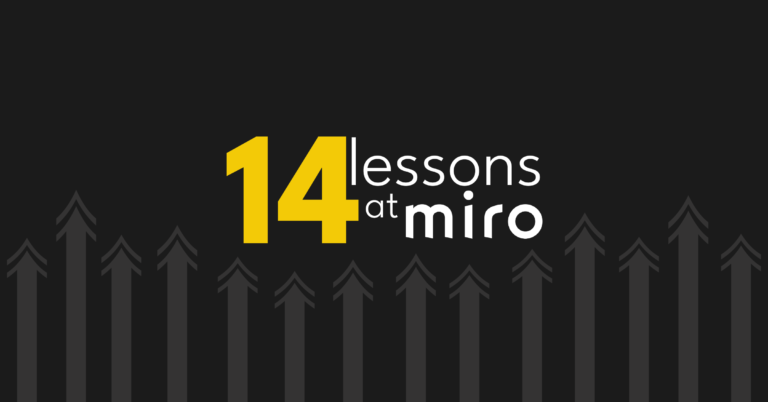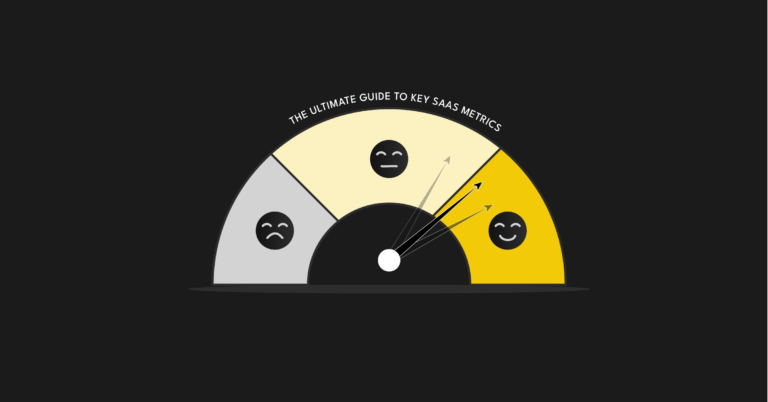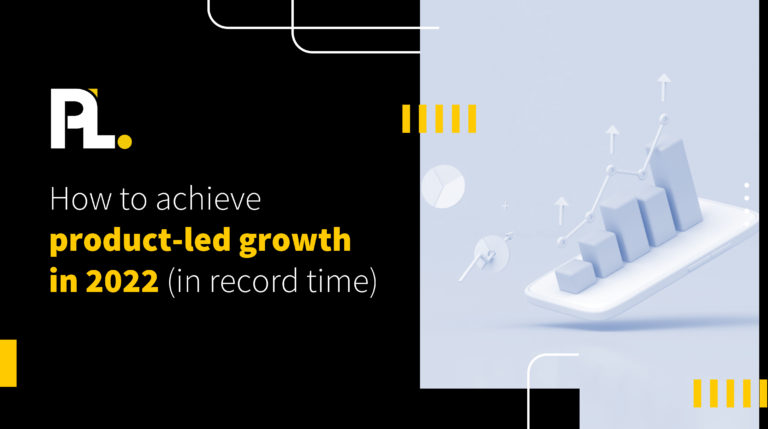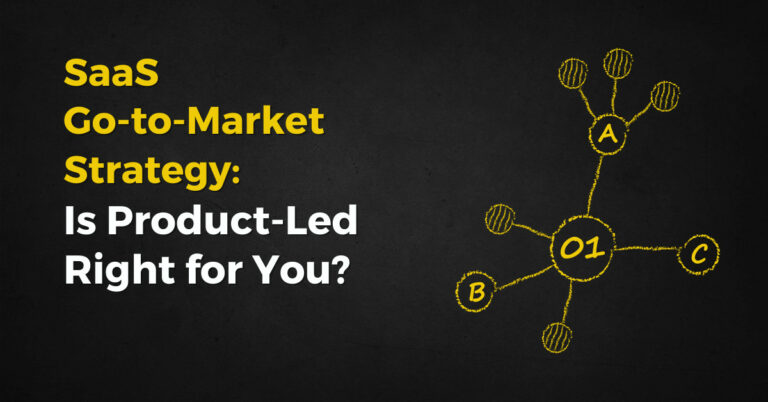Customer acquisition encompasses everything a business does to get new customers — from generating and converting leads, to designing a great customer experience and turning users into brand champions who recommend the product to others.
Clearly, there are many independent processes, activities, and departments involved in customer acquisition. That’s why you need a solid strategy to ensure everyone’s on the same page.
Your customer acquisition strategy is a high-level plan that determines the tactics and channels you'll use to attract the right customers to your business.
The best strategy for each company will vary depending on factors such as:
- Who your ideal customers are.
- How much it costs to acquire them.
- How much they spend on your products.
- How fast you’re trying to grow.
However, many companies jump straight into testing acquisition channels and tactics without considering these factors. This often leads to:
- Spending time and money on initiatives that don’t produce results.
- Using channels that attract customers at a loss, while ignoring ones that can be a better fit for your business.
That’s why we’ll start this guide by discussing the four essential factors for building successful customer acquisition strategies.
Then, we’ll go over 14 customer acquisition tactics and channels and explain how to select which ones you should include in your strategy.
Change is hard, whether you’re shifting your acquisition strategy or simply adopting new channels and tactics. That’s why we created the ProductLed Academy to equip teams with the knowledge, resources, and skills to implement product-led growth. To learn more, take our free workshop to show you how to activate the 3-step system that turns your product into a predictable, revenue-generating machine.
The Framework: 4 Essential Factors for a Successful Customer Acquisition Strategy
The right acquisition strategy for each company is determined by four key factors:
- Its customer lifetime value (LTV) and customer acquisition cost (CAC).
- The behavior, motivations, and challenges of its ideal customers.
- The business’s long-term goals.
- Its go-to-market strategy.
Evaluating these factors lays the foundation for your strategy since it impacts the channels and tactics you’ll use throughout the entire customer acquisition process.
Factor #1: LTV and CAC
LTV is a metric that shows how much revenue you can expect from a customer during the entire relationship.
Here’s the formula for calculating it:
LTV = Average Purchase Value x Average Number of Purchases x Average Customer Lifespan
For example, say your average customer makes two purchases worth $500 every year and they stay a customer for three years. In that case you’d have an LTV of $3000 [$500 (average purchase value) x 2 (purchases per year) x 3 (total years)].
The other side of this coin is your CAC. At a high level, you can calculate the CAC for each marketing campaign or activity by dividing your marketing costs by the number of customers acquired.
CAC = Marketing Costs / Customers Acquired
There’s also a more complex CAC formula that includes additional factors:
CAC = Marketing Costs + Wages for Marketing and Sales + Marketing and Sales Software + Outsourced Services + Overhead for Marketing and Sales / Customers Acquired
This formula provides a high-level overview of customer acquisition costs, so it should be applied to longer time frames, such as quarters or fiscal years.
So, why does all of this matter?
Because your LTV and CAC dictate your strategy by narrowing down the channels and tactics you can use.
For example, cold calling and other sales-heavy tactics require, well, salespeople. If you have a relatively low LTV, you won’t be able to cover the cost of their wages and turn a profit. This means product-led tactics with a lower CAC can be a better option.
Factor #2: Ideal Customers
A simple way to determine who your best customers are is to look at the LTV of each customer segment. The larger it is, the more likely this type of customer can sustain your business in the long run.
CAC can be another factor, as customers who are too expensive to acquire relative to the LTV will make it harder to turn a profit.
Additionally, you can factor in which customers are the easiest to onboard and work with, as well as which ones get the most value from your product.
However, this is only part one of the equation.
To consistently attract potential customers, you need to know who they are, while understanding their habits, needs, and pain points.
Without this, you don’t really know:
- Where your ideal customers hang out (be it offline or online). This oftenleads to spending money on channels that can’t even reach your target audience.
- What challenges they’re facing, making it very hard to entice them into trying your product. Plus, not knowing their challenges means you can’t consistently guide them to the “aha” moment, which will result in poor customer retention and a low free-to-paid conversion rate.
For B2B companies, it’s often useful to develop both an ideal customer profile (ICP) and buyer persona:
- Your ICP is a made-up company that has everything you’re looking for in a perfect fit for your product or service. An ICP can be defined by the industry, company size, revenue, budget, and other similar characteristics.
- Your buyer persona is a fictitious (or often semi-fictional) representation of individual users. Buyer personas take into account people’s goals, motivations, challenges, job titles, and demographics.
If you don’t have this information yet, start talking to your customer-facing teams — they usually have tons of useful insights on this topic. You can also survey your customer base directly.
Factor #3: Long-Term Business Goals
For some startups, the most essential goal is user growth.
These businesses aren’t concerned with profitability or massive revenue increases yet. Instead, they’re trying to get as many new customers as possible, refine the product based on their feedback, and reach product-market fit.
For example, say your 3-year-old startup sells software to website owners, and it’s currently installed on 10,000 websites. In the next year, you want to grow that 10x to 100,000 websites.
This goal impacts the selection of channels and tactics because you’ll need to focus on ones that can reach a lot more potential customers than the channels you’ve relied on so far.
Additionally, if user growth is your number one goal, then you can temporarily acquire customers at a loss (i.e., CAC > LTV). Most venture-backed startups do this for years before turning a profit.
However, for other businesses, profitability and sustainable revenue growth might be more important than growth at all costs. This is often the case with bootstrapped businesses or late-stage startups that already have product-market fit and are hunting profitability.
In these cases, CAC becomes a crucial factor alongside LTV. Expensive channels and tactics hinder profitability, so they have to be optimized or eliminated from the strategy.
Factor #4: Go-to-Market Strategy
Product-led and sales-led go-to-market (GTM) strategies rely on different methods and departments for customer acquisition.
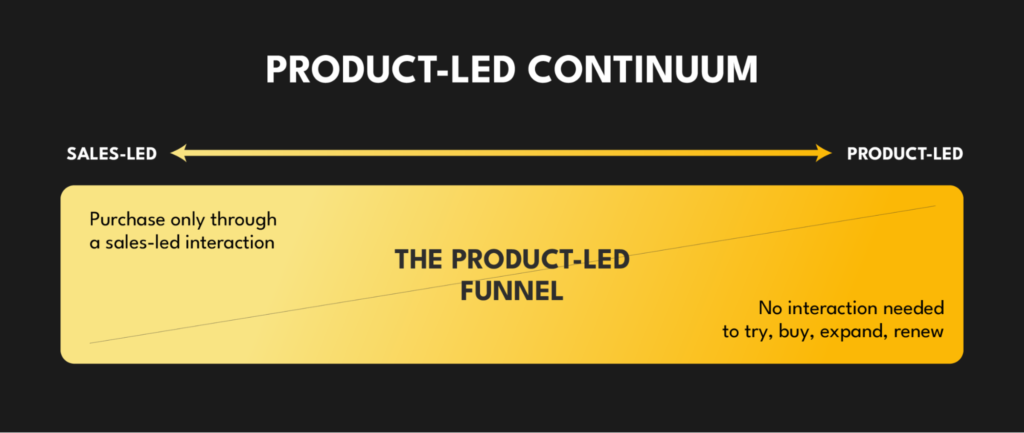
On the one hand, sales-led strategies put sales at the forefront of customer acquisition.
The sales team is the primary driver that generates leads, converts them into customers, and helps them renew or upgrade. Cold calling, cold emailing, trade shows, and conferences are popular channels for sales-led businesses.
One of the biggest benefits of this GTM strategy is the ability to close accounts with high LTV. As a result, being sales-led is often ideal for hyper-niche solutions with a small total addressable market (TAM) and for enterprise companies like IBM, Oracle, and SAP.
The main downside of this strategy is the large CAC because of the cost of the sales team and the often months-long sales cycle.
On the other hand, product-led growth puts the product at the center of customer acquisition.
The buyer can try the product for free, experience its value, and upgrade to a paid plan — all without needing to interact with a sales team. This is possible because product-led companies, like Slack, Dropbox, and DocuSign, have additional acquisition tactics at their disposal, such as freemium products and free trials.
Because customers can self-serve, the CAC is usually much lower compared to a sales-led GTM.
Additionally, investing in a product-led user experience transforms the traditional acquisition funnel into a flywheel. The flywheel model builds momentum from one phase to the next, turning beginners and evaluators into loyal customers and champions who tell others about your product.
This is a highly nuanced topic, so check out our blog post on product-led vs sales-led models for more details.
14 Customer Acquisition Tactics and Channels to Choose From
Before we dive into the tactics and channels, note that many of the ideas in this section are based on the book “Traction” by Gabriel Weinberg and Justin Mares.
We’ll do a brief overview with examples, but if you want a more in-depth explanation, consider getting the book or reading this blog post by Zapier.
1. Freemium Products, Free Trials, and Demos
Freemium products, free trials, and demos are a crucial part of any product-led organization’s toolkit.
Here’s a quick breakdown of all three:
- Freemium products can be used by customers without paying and without a time limit. The idea is to solve beginner problems in your niche for free while monetizing the more advanced use cases. Some of the biggest SaaS companies have a freemium version, including Dropbox, Slack, HubSpot, and Calendly. And while it's a powerful way to attract customers, freemium should be used with caution. We constantly see startups adopt this model, without making it easy for customers to understand their freemium product, get value from it, and upgrade to paid. We’ve explained the freemium business model in-depth in this article.
- Free trials allow customers to try the product for a limited time, after which they have to upgrade or stop using it. A free trial should make users feel like they can’t go back to how they were solving their problem before they discovered the product. However, many companies don’t provide that experience, because they don’t align their free trial with their users’ goals. We’ve explained how to overcome this problem and improve your free trial conversion rate in this article.
- Demos allow prospective customers to book a product tour with your sales team. Demos are a classic tool for selling enterprise products like Adobe Analytics, Oracle HCM, and SAP Enterprise Resource Planning (ERP). However, using demos doesn’t exclude freemium products and free trials, and vice versa. Some organizations employ a hybrid model, where part of their customers self-serve, while others (usually larger customers with complex use cases) rely on demos with the sales team.
Again, this is a complex topic, so check out Chapter 2 of the Product-Led Growth Book on the differences between freemium, free trials, and demos.
2. Affiliate Programs
Affiliate programs allow product users, bloggers, and other influencers to earn a reward for promoting your product. The reward can be money (e.g. a percentage of each sale they bring in), free credits for your product, or a mix of both.
The most popular example of this is Amazon. Anyone can register for an Amazon Associates account, get an affiliate link, and send it to their audience. When someone follows the link and buys the product, the affiliate earns a commission.
3. Email Marketing
Email is one of the oldest digital marketing channels, but it’s still relevant today. Email marketing and automation tools like Klaviyo, Drip, and ConvertKit empower teams to:
- Generate new leads.
- Nurture them into becoming customers.
- Re-engage existing customers and much more.
Put simply, email is a powerful way to get customers and boost engagement throughout their entire lifecycle. You can find many examples of awesome emails here.
4. Traditional Public Relations (PR) and Unconventional PR
Traditional PR involves reaching out to blogs, magazines, newspapers, and other outlets to get a featured story.
On the flip side, unconventional PR is about going viral by doing something interesting or even outlandish.
For example, Red Bull produces hundreds of videos — like the one below — in which people do crazy stunts with the Red Bull logo in the background:
When the videos go viral, so does the Red Bull brand.
Another example from the B2B space is Postman’s 30-page graphic novel on APIs.
5. Search Engine Marketing (SEM) and Search Engine Optimization (SEO)
SEM is the process of promoting a business using pay-per-click (PPC) ads that appear on search engine results pages.
For example, when you search for “B2B accounting software” in Google, you’re immediately greeted with four SEM ads:
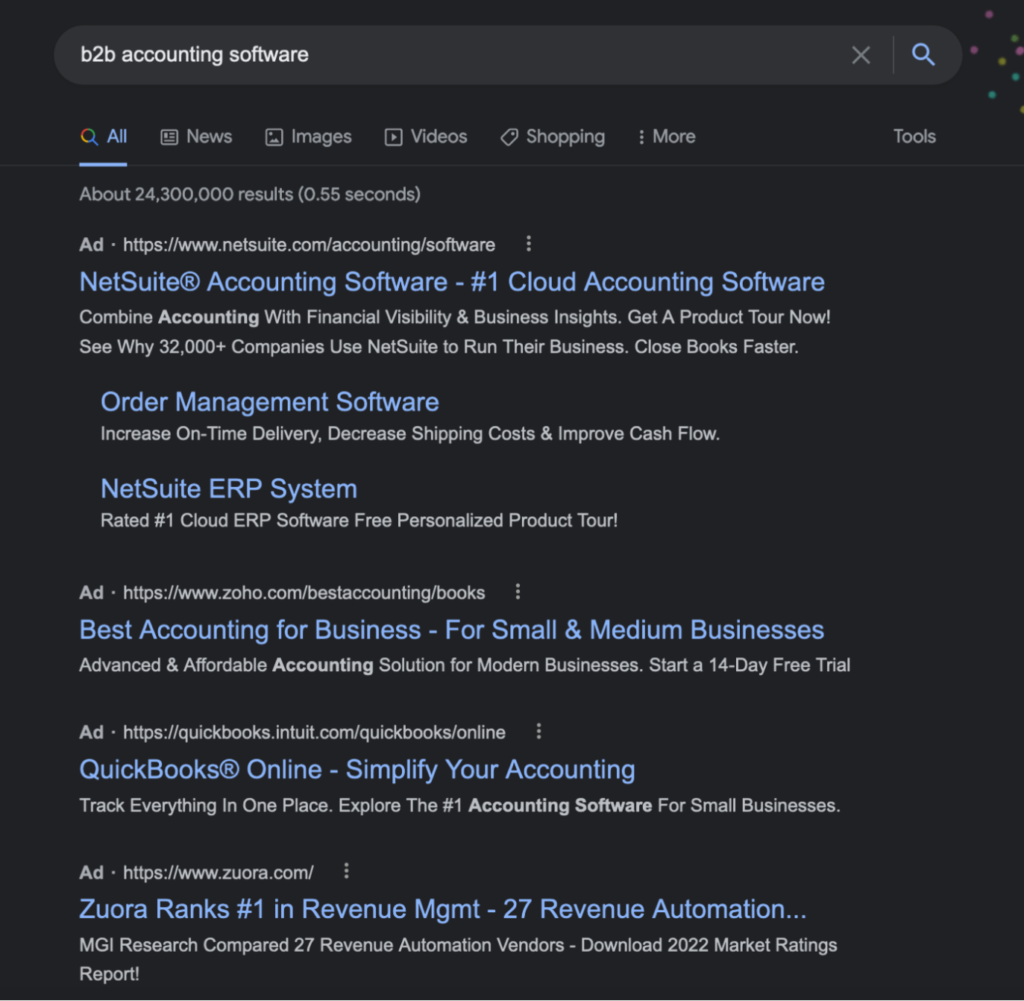
Google remains by far the most widely-used search engine, so it’s usually the first choice for SEM. However, its popularity has led to fierce competition and rising costs, so alternatives like Yahoo, Bing, and DuckDuckGo are also viable options for some businesses.
Like SEM, SEO also involves using search engines to promote your business. The big difference is that with SEO, you’re not paying for placements in search engine results pages. Instead, you’re trying to rank in the organic search results for terms that your potential customers would be searching for.
SEO is also one of the most popular forms of inbound marketing — a methodology that aims to attract customers by creating quality content for them, instead using ads and other interruptive methods.
For example, Hootsuite — a platform for managing social media marketing activities — targets hundreds of keywords with their content, like “How to schedule Instagram posts”:
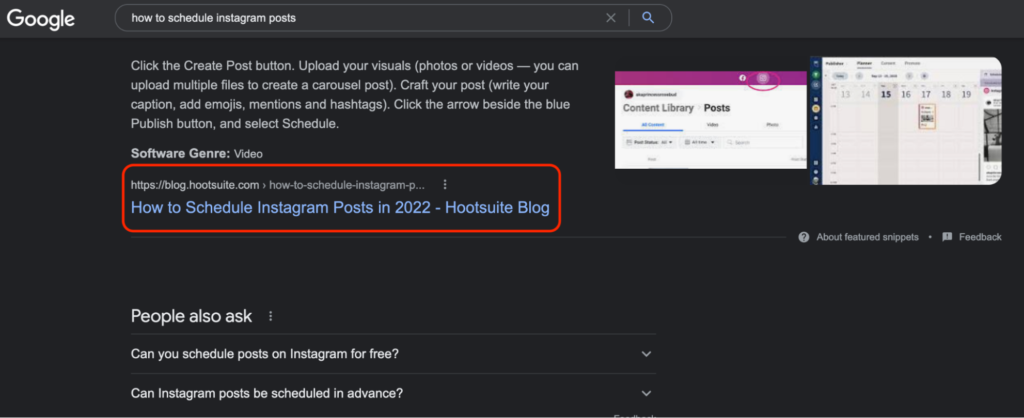
This marketing strategy helps them acquire customers and build authority in their niche.
6. Social and Display Ads
Social ads allow you to put your product in front of people while they’re browsing social media, while display ads can be served on other people’s sites via ad networks like Google’s Display Network.
Unlike search engine ads, which are intent-based, social and display are disruptive, since people aren’t usually looking for products or solutions to their problems. However, they’re still powerful tools for both brand awareness and conversions, thanks to their reach (Facebook ads alone can reach billions of people) and retargeting capabilities.
7. Offline Ads
While most B2B SaaS companies don’t utilize them, offline ads can be a great way to present your brand differently.
For example, Lattice — a B2B people success platform — experimented with catchy billboard and subway ads:

Their former VP of Marketing, Alex Kracov, shared his learnings from this experiment in this blog post.
Note: Measuring CAC, cost per acquisition (CPA), or attribution for offline ads is very difficult or often impossible. If you’re looking for something that produces easily attributable results, consider social ads, SEO, and content marketing.
8. Targeting Blogs
This tactic involves finding bloggers in your niche, building mutually-beneficial relationships, and having them promote your products.
This can be as simple as reaching out to them with ideas for guest posts. Or, you can reference their articles in your content as a way to start the relationship.
Leo Widrich, co-founder of Buffer, actually used guest posting to help grow his company from 0 to 100,000 users in nine months. He shared some of his ideas in this interview, which is a great read if you’re interested in this customer acquisition method.
9. Content Marketing
Content marketing is the process of creating and distributing various types of content — articles, videos, landing pages, etc. — with the goal of attracting customers.
There are many places this content can be posted, from your blog and social media pages, to digital media outlets and other third-party websites.
Ahrefs is a great example of a company that leverages content in different ways. They have a blog, where they publish articles that rank high in Google for important keywords. They also have a YouTube channel and an academy, both of which drive leads and show potential customers how to solve their problems using Ahrefs products.
10. Community Building
Community building includes various online and in-person activities aimed at building a community that helps attract and retain users.
Many companies rely on tools like Facebook, Discord, and Slack to create their community and keep it updated, while also using regular meetups and conferences to strengthen its bond.
For example, the ProductLed Slack Community is the largest product-led growth community in the world, with more than 13,600 members. Beginners and product-led veterans alike use the community to learn and share industry best practices and get questions answered by peers and experts. Many of them continue their learning by enrolling in the ProductLed Accelerator.
11. Viral Marketing
Viral marketing occurs when your current customers bring new ones to your product, without you having to attract those new customers via ads or other marketing efforts.
This can take many different shapes, like:
- Inherent virality, also called network effect, where the value for users increases when other people sign up. Social media apps like Facebook and Instagram, and e-commerce marketplaces like eBay and Etsy are classic examples of this mechanism.
- Collaboration, where products benefit from (or simply require) having multiple users. Think Asana, Trello, Basecamp, and other project management tools.
- Communication, where the product is meant for communicating with others (e.g., Zoom, Telegram, or Skype).
- Incentives (or referral programs), where users get rewards for inviting their friends (e.g., Uber, Dropbox, and Wise).
- Embedding, where your product is embedded on other people’s sites, exposing new customers to it (e.g. SurveyMonkey and Vimeo).
- Word-of-mouth, where customers tell their friends about your product.
It’s important to note products don’t just go viral automatically. Instead, they rely on carefully designed viral loops, which encourage users to try the product and then invite or simply tell their friends about it.
We have a detailed interview with Mixmax’s CEO on how to master product virality, which you can watch below:
12. Sales
A sales team can do all kinds of activities, including lead generation (e.g. cold calling and cold emails), lead qualification, and turning leads into paying customers. As we said above, this is the primary acquisition method for sales-led businesses, especially those targeting enterprise customers.
13. Offline Events
You can test whether offline events work for you by:
- Attending trade shows, where you can rent a booth and provide information about your products and services.
- Hosting your own events, which is more difficult, but can be a powerful way to grow your community and become a thought leader in your industry. For instance, ConvertKit has become famous for their annual Craft + Commerce event for online creators.
- Securing speaking engagements, which is often a useful way for new businesses to get established in their field.
14. Engineering as Marketing
This is another classic tactic for product-led businesses. It involves building mini apps and tools that provide value to your audience for free. The goal is to naturally lead users of the free app to become customers of your paid product.
Moz’s Meet Link Explorer — a free backlink checker — is a great example. You can use it for free and get link data for any URL. And, since Moz sells various SEO solutions, this link explorer is a natural lead-in to their paid products.
How to Choose the Right Acquisition Channels and Tactics for Your Business
In this section, we’ll show you how to prioritize and test which activities work for your businesses. The goal is to find the right channels and tactics and then focus all your customer acquisition efforts on them.
Prioritize What to Test First
Again, the book “Traction” has useful advice on prioritization, based on the Bullseye Framework shown below:
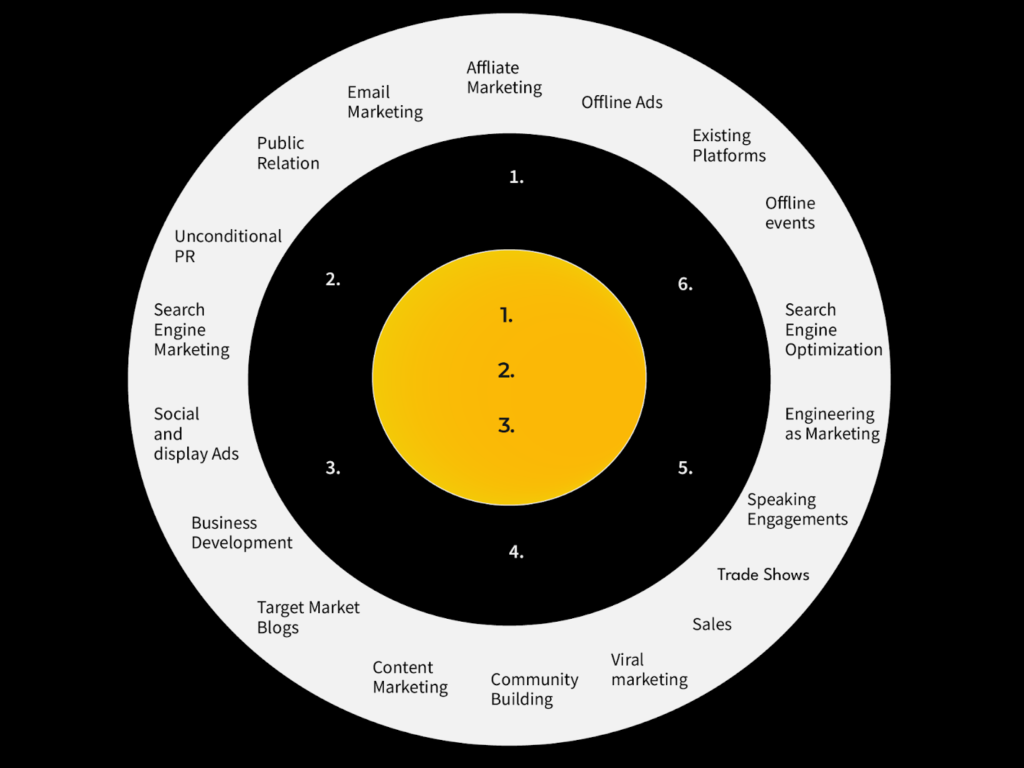
The idea is to list all available tactics and channels in the outer gray circle and remove the ones that you’ve already tried. Then, put the remaining ones in a spreadsheet (feel free to copy ours) with four columns:
- Potential: On a scale of 1 to 5, how much potential do you think there is in this channel?
- Cost per acquisition (CPA): How much would it cost to acquire leads via this channel?Note: CPA is not the same as CAC. CPA is the cost to acquire trials, demos, or any other type of lead. This blog post offers an in-depth explanation of this topic.
- Customer reach: How many potential customers can this channel or tactic reach?
- Time to test: How long would it take for you to test this?
Based on the answers, start filling out the other two circles. The middle black circle is for channels and tactics with potential, while the inner yellow one is for the ones you think will work best.
Here’s an example of a filled-out framework:
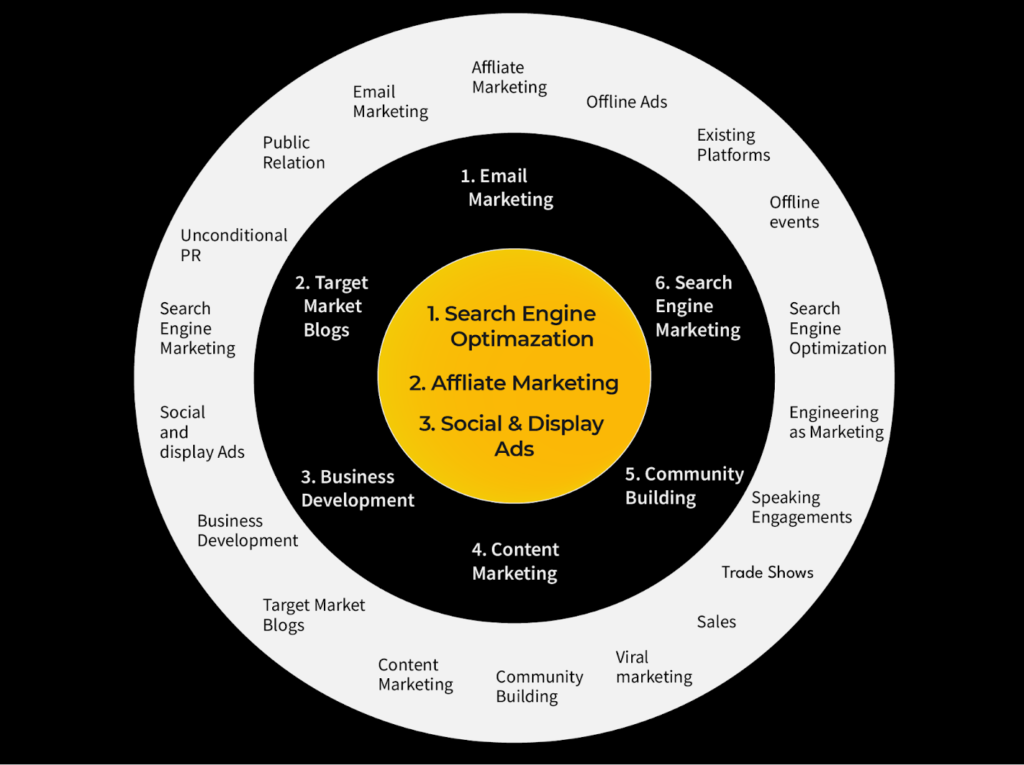
Test to See if the Top 3 Picks Produce Results
From here, you can start testing your top three picks. The goal is to perform quick and cheap tests that can answer the following questions:
- How many customers are available through this channel?
- How much will it cost to acquire customers through this channel?
- Are the customers that you are getting through this channel the kind of customers that you want right now?
- What hooks and calls to action work best for getting people to sign up?
It’s also important to analyze how customers from each channel behave once they arrive on your site and start using your product.
Google Analytics is a great free option for this, along with more advanced tools like Smartlook and Mixpanel that provide more insights into the entire customer journey.
Start Testing Again or Double-Down on What Works
After your tests, it may turn out that your top picks aren’t the right ones for you.
Maybe they produce an unsustainable CAC or don’t bring the right customers for your business. Regardless of the problem, in these cases, it’s time to start testing the next six options.
But if you find a channel or tactic that works — put all of your efforts into it.
One of the biggest mistakes we see startups make is not doubling down on activities that produce results. Instead, they try to diversify their acquisition channels too early and end up missing the chance to scale.
As we noted in our guide to acquiring free trial users, most established companies, including giants like Facebook, LinkedIn, and HubSpot, received over 80% of their growth from one channel when starting out.That’s the norm, not an exception.
In short, don’t be afraid to put all your resources into the channels that work for you. Once you’ve maxed them out or hit a plateau where they no longer satisfy your revenue goals, go back to experimenting.
Build a Product-Led Customer Acquisition Strategy Tailored to Your Business
Creating a product-led strategy for your business is just one key part of building a successful SaaS product, but it’s connected to every aspect of your business. In ProductLed Academy, we cover strategy as part of the ProductLed Method, so you can build a self-serve model that converts.
ProductLed Academy is a 12-month coaching program, where you'll work directly with Wes Bush to master each of the nine components of a successful product-led business (we spend around six weeks on each of these):
- Vision: What is your company really good at?
- User: Who do you serve best?
- Model: How do you create a ton of value for your users to win?
- Offer: Have you crafted an irresistible free offer for your ideal users?
- Experience: Have you created an effortless path to value for your users?
- Pricing: Is it easy for users to upgrade without talking to anyone?
- Data: Do you know where users are getting stuck in your product?
- Process: Do you have a growth process that enables your team to build out experiments, prioritize the high-impact ones, and launch the ones that are easiest?
- Team: Is your team full of A players capable of taking you to the next level?
While you can have one or more of these dialed in perfectly, if you’re missing one of these key players, you’re going to have a hard time with growth.
If you're ready to break through to the next level and create a winning product-led strategy, be sure to check out ProductLed Academy.

